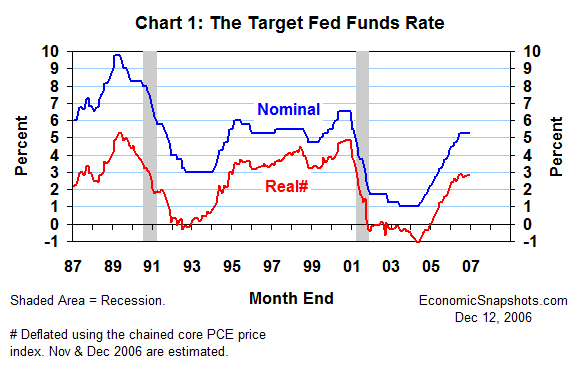
| Back to Index |
December 12, 2006 – The FOMC voted today to leave its Fed funds target unchanged at 5.25%, continuing the “wait and see” monetary policy stance first adopted in August. Before August (from June 2004 through June 2006), the FOMC had been tightening steadily, raising its Fed funds target by a total of 425 basis points in a long string of 25 basis point increments (Chart 1).

Richmond Fed President Lacker voted against today’s policy decision, as he has done since August. Lacker would have preferred to raise the Fed funds target by 25 basis points to 5.5%.
According to the FOMC’s post-meeting policy statement, “Readings on core inflation have been elevated, and the high level of resource utilization has the potential to sustain inflation pressures.” (That’s exactly the same language as the last FOMC statement in October.) Thus, the FOMC remains more inclined to tighten than to ease in coming months.
At the same time, however, the FOMC majority continues to believe that the slowing economy will eventually rein in inflation, without further Fed tightening action.
As far as the possibility of too much economic slowing is concerned, “Although recent indicators have been mixed, the economy seems likely to expand at a moderate pace on balance over coming quarters.” That’s a more complex message than the last FOMC statement, which simply said “Going forward, the economy seems likely to expand at a moderate pace.” (Differences are highlighted in red.)
With this new wording, the FOMC seems to be reminding us that it is not in business of managing U.S. economic growth on a sector by sector basis. (Monetary policy is far too blunt for that kind of fine tuning.)
In particular, as long as the total economy seems to be growing ok (which seemed to be true through November, as suggested by the November employment report), we should not expect the FOMC to move to bail out a sagging housing market or a stalling manufacturing sector with easier monetary policy.
Bottom line: As long as the total economy continues to evolve in line with the FOMC majority’s forecast, the outlook will continue to favor a long stretch of unchanged U.S. monetary policy.
Suzanne Rizzo